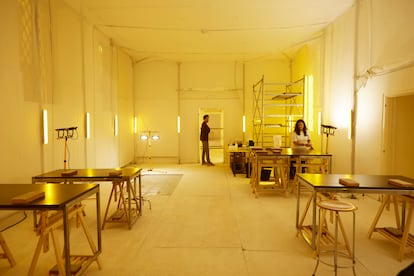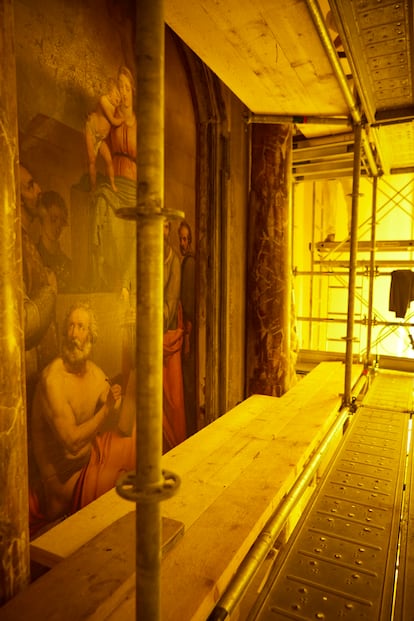This is as simple as some architects are talking about the end of the world and a group of architects has thought how to start the afternoon better. “This pavilion It is very radical because it is extremely simple. ”Tatiana Bilbao describes his intervention: architecture as collective care and responsibility. As art capable of facing contemporary social and ecological challenges, it coincides, in ambition, with the Laudato yesthe encyclical of Pope Francis who speaks, like San Francisco de Asís, to “treat the house as a sister”; That is, the responsibility of sharing a common house. The Holy See Pavilion at the Venice Architecture Biennial, which has obtained a special mention among the winners in this 19th edition, is on everyone’s lips. It is different.
“Venice has a very difficult relationship with the Architecture Biennial. On the one hand, it supports it because it needs the income it produces. On the other, the architectural debate passes from tiptoe through the city. It leaves no mark.” Anna Puigjener, by Maio Architects, is the other designer behind the new Holy See in Venice. It is, in reality, a rescue intervention – more than restoration – that denounces the irrelevance of many architectural interventions during the architecture biennial. The rescued can be a lot. Here only walls, fresh and physical architecture are not repaired, the meaning of architecture, the Venetian cultural fabric, the neighbors communities of the Santa Maria Ausiliatrice church itself, turned into the social center in the neighborhood of Castello, very close to the gardens that the national pavilions show. The intervention is thus pure Christianity. Rescues, in reality, the poverty of spirit in which the most naked Catholicism finds true wealth.
Only three editions ago that the Vatican Dicastery of Culture decided that, reconnecting with its centuries of artistic patronage, would order a pavilion for the Venice Architecture Biennial. It happened in a big way, several of the most recognized architects in the world – from Souto de Moura to Norman Foster – signed seven chapels in the monastery gardens of the island of San Giorgio Maggiore. Those pavilions were so sensed, they related to the low vegetation that grows in Venice in such a natural way, that they became a permanent footprint.
However, that success, for the Pope and the curia, could only be architectural. They wanted more. “His new cardinal in command of the Dicastery of Culture indicated that art in the 21st century should put man – to humanity – in the center,” explains Tatiana Bilbao. So, for the next edition, Álvaro Siza’s intervention in the monastery garden consisted of caring for crops, opening an inner garden to neighbors and visitors and sharing seeds and flowers to make infusions.
Along the same lines, in the last art biennial, the intervention of Maurizio Cattelan With my eyes Forced visitors to cross the process that involves accessing a women’s prison: check, naked … once inside you knew some of the jailed women who had worked with the artists for a year.

That is the spirit with which three architects thought the new Pavilion of the Holy See. Open work It combines the opening of the work in the church of Santa Maria Ausiliatrice to the inhabitants of the Castello neighborhood with their rescue – they do not speak of restoration – and its conversion – at least temporary – in the Restoration School and Social Center. Let’s see how it works.
From the hand of the young Portuguese cardinal José Tolentino de Mendoça, this time the selected architect was Tatiana Bilbao. The Mexican chose to work as it does when she lifts social homes or public spaces: sharing the project. Thus, he called Anna Puigjener (Maio Architects) and Marina Otero Verzier, with experience in police stations at the Venice Biennale. Together they began to add ideas: to dedicate money to restoration to convert that restoration into trades classes to learn to work with plants, ceramists, painters or restaurateurs. The architects added the project to the Venetian Giovanna Zabotti, artistic director of Fondaco Italia. And this began to build bridges with neighborhood associations. The social uses came then: beyond the workshops, the reception. From the Conservatory, for example, they asked for space for musicians with the larger instruments – pianists, percussionists – could rehearse there. The workshops and neighborhood meetings would have a musical background.
Thus, with an architecture that consists in avoiding damaging more the ruins of the Church and avoiding harming with protection fabrics, some scaffolding and yellow emergency lights, Tatiana Bilbao study and Maio Architects solved their intervention. The rest will work by Otero Verzier and Zabotti with visitors, artisans and neighbors.

Raised in the twelfth century as a hospice for pilgrims, the property where this pavilion is celebrated was the first hospital in Venice. In the XVIII it became parvulnio. And in 2001 the Venetian City Council decided to allocate it to cultural use. Since then I expected restoration. During the next four years the Vatican will be responsible for managing it from the guidelines established by the curators.
Last Friday, when the intervention was inaugurated, a neighboring old woman looked out a window to the patio. It wasn’t the old woman from the creep. “This morning has come down to sweep the cloister,” Bilbao told me. He contemplated the miracle of seeing how the ruin he saw from his window charged new life.

